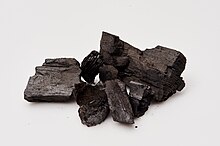Our website is made possible by displaying online advertisements to our visitors.
Please consider supporting us by disabling your ad blocker.
Charcoal


Charcoal is a lightweight black carbon residue produced by strongly heating wood (or other animal and plant materials) in minimal oxygen to remove all water and volatile constituents. In the traditional version of this pyrolysis process, called charcoal burning, often by forming a charcoal kiln, the heat is supplied by burning part of the starting material itself, with a limited supply of oxygen. The material can also be heated in a closed retort. Modern charcoal briquettes used for outdoor cooking may contain many other additives, e.g. coal.
The history of wood charcoal production spans ancient times, rooted in the abundance of wood in various regions. The process typically involves stacking wood billets to form a conical pile, allowing air to enter through openings at the bottom, and igniting the pile gradually. Charcoal burners, skilled professionals tasked with managing the delicate operation, often lived in isolation to tend their wood piles. Throughout history, the extensive production of charcoal has been a significant contributor to deforestation, particularly in regions like Central Europe. However, various management practices, such as coppicing, aimed to maintain a steady supply of wood for charcoal production. The scarcity of easily accessible wood resources eventually led to the transition to fossil fuel equivalents like coal.
Modern methods of charcoal production involve carbonizing wood in retorts, yielding higher efficiencies compared to traditional kilning methods. The properties of charcoal depend on factors such as the material charred and the temperature of carbonization.
Charcoal finds diverse applications, including metallurgical fuel in iron and steel production, industrial fuel, cooking and heating fuel, reducing agent in chemical processes, and as a raw material in pyrotechnics. It is also utilized in cosmetics, horticulture, animal husbandry, medicine, and environmental sustainability efforts, such as carbon sequestration.
However, the production and utilization of charcoal can have adverse environmental impacts, including deforestation and emissions. Illegal and unregulated charcoal production, particularly in regions like South America and Africa, poses significant challenges to environmental conservation efforts.
Previous Page Next Page


